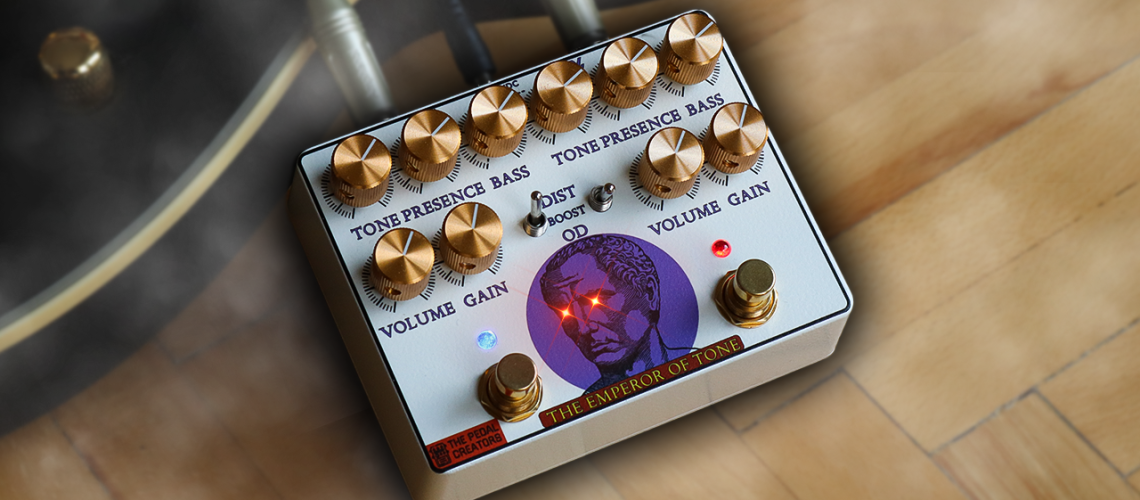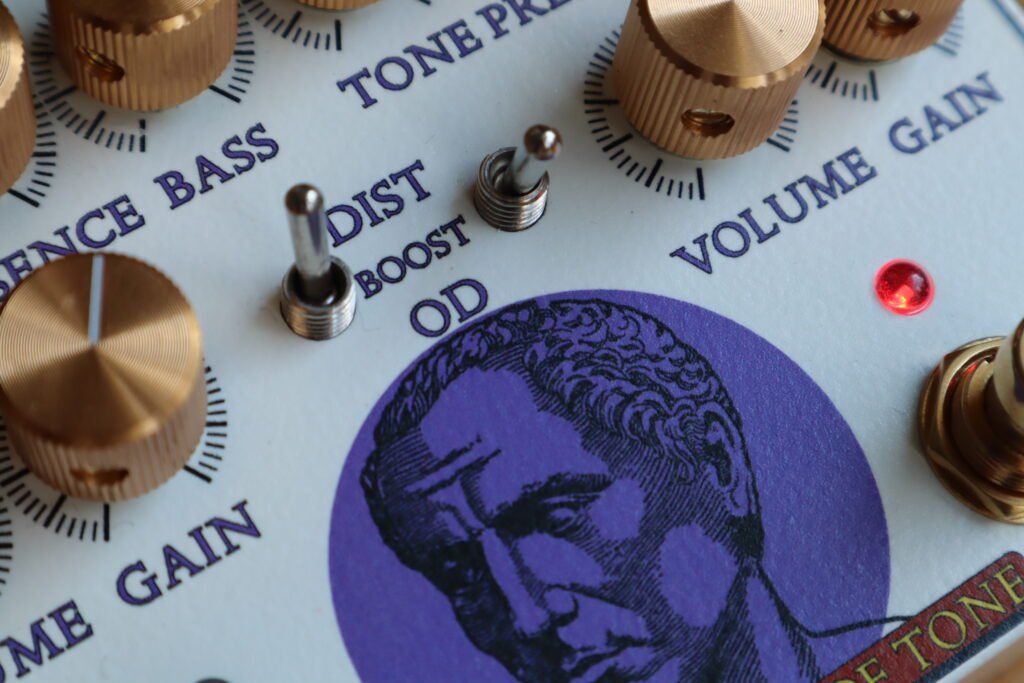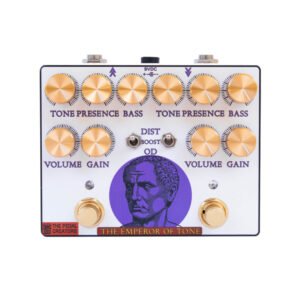
The Pedal Creator
How the Emperor of Tone came to life
- September 6, 2023
- , 1:28 pm
- , Uncategorized
Introduction
The pursuit of the perfect guitar tone is a journey every guitarist knows well. I too had that dream, the dream of owning the legendary King of Tone (KoT). However, the reality of long waiting lists and sky-high reseller prices made it feel like an impossible dream, especially on my budget.
This is where my journey began – the search for a worthy alternative. I immersed myself in the world of Bluesbreaker-type of pedals, opening them up, inspecting every circuit, and meticulously studying their inner workings. KoT clones, revered pedals like Morning Glory, Protein, Kingtone Duelist, stacked Marshall Bluesbreakers, and even an original KoT a friend of mine lent me for science – I explored them all.
But, there was always something missing; while these pedals were undeniably good, they fell short of my vision of perfection. It was as if they each held a piece of the puzzle but lacked the full picture.
I set out on a mission determined to create the most perfect overdrive worthy of holding the title of The Emperor Of Tone.
I began building my own clones, continually tweaking and experimenting with different values, op-amps, components, knobs and toggles. With each new clone I constructed, I gained valuable insights and discoveries that would contribute to what I envisioned as the perfect overdrive.
Table of Contents
Let’s dive into what makes the Emperor of Tone truly unique
Ease of use:
To enhance your playing experience, I added an external toggle that effortlessly switches between three modes – overdrive, boost, or distortion. I applied the same principle to the presence pot, extending its range to adapt to any guitar. These controls were originally hidden inside the King Of Tone, but it made sense to bring them to the forefront. Whether you’re experimenting with various gain stages or using different guitars, these features allow you to sculpt your tone precisely.
Extremely versatile tone
To cater to different gear and playing styles, I introduced a bass knob. It ranges from a tight tone suitable for modern players to a full, fat bass tone that thickens up any single-coil guitar. This feature is especially handy when stacking both channels. I took inspiration from the Kingtone Duelist’s toggle for switching between Stock/Fat/Glassy modes but replaced it with a more user-friendly potentiometer. This allows you to dial in the perfect balance between tightness and fatness with precision.
Voltage Pump
The real magic happens inside the pedal. I have a habit of plugging every overdrive pedal I own into an 18v power source to see what happens. You’d be surprised by how much voltage can affect headroom, compression, and gain in your signal. But most Bluesbreaker-type pedals were not designed for this, so you risk doing permanent damage to the circuits. Plus, not all power supplies offer an 18v output.
That’s why I incorporated an internal charge pump into the Emperor that turns your 9volt voltage input into 18v, controlled through internal switches tha allow you to independently assign the voltage for each channel, unleashing total versatility and control over your tone.
Previous
Next
Choose your own combination!
High-Gain built-in mods
In the world of pedal modifications, the High-gain mod reigns as one of the most common and beloved enhancements for this type of pedal. Most renowned pedal builders typically offer this mod by request.
As a guitarist who enjoys dwelling in the high-gain realm, I get turned on every time I see a toggle that says MORE GAIN, it was a no-brainer to include this feature on the Emperor Of Tone.
However, to preserve the authentic low to mid-gain character intrinsic to transparent overdrives, I included an internal dip switch, allowing for a seamless transition between the stock and High-gain modes. Much like the array of internal trim pots within the Emperor of Tone, making it easy to configure the gain mode independently for each channel, delivering you an expansive palette of tonal landscapes.
A Diode Delight
The diode section within Analogman’s KoT has sparked fervent discussions across internet forums and blogs, with a particular focus on the enchanting MA856 and 1S1588 diodes, known for their roles in Soft and hard clipping, respectively. These components are often celebrated as the secret sauce behind the pedal’s magic.
However, let’s unveil the truth: after an extensive journey of testing, which included elusive NOS Japanese diodes, Soviet germanium, LEDs, BAT, Schottky, and an array of others, we discovered was a fascinating tapestry of distinct clipping responses from each diode type. Yet even in blind tests, neither of them, (including the MA856 and the 1S1588) emerged as indisputably superior options compared to the rest of the diode pool.
The choice of clipping diodes can radically influence the compression and drive of your signal. This understanding led us to introduce two internal toggles for each channel, granting you the power to craft your preferred diode combination. For the Overdrive Soft clipping diodes, we noticed that the most significant tonal shifts didn’t solely hinge on the diode type itself but rather on the interplay between Symmetrical clipping (utilizing two sets of diodes in a row) and asymmetrical clipping (with a 2 to 1 ratio)
With the Soft clipping internal toggle, you can set your overdrive mode to Symmetrical or Asymmetrical clipping.
As for the Distortion Hard clipping diodes, we opted for stock BAT46 diodes, accompanied by three vacant slots awaiting your custom selection. Whether you crave a pair of symmetrical, velvety germanium diodes or the open crunch of three asymmetrical LEDs, the choice is yours. We’ve got your tonal desires covered.
10% Off Your first Order
Enhanced Signal Integrity
To ensure your signal remains pristine, I added an external buffer that maintains unity levels around noon on the volume knob. This is in stark contrast to vintage overdrives, where maxing out the volume is often required to achieve unity when overdrive or distortion modes are engaged. To further fine-tune your setup, I included an internal trim pot, allowing you to dial in the desired impedance for each side of the circuit. This feature ensures compatibility with both active and passive pickups, making the Emperor of Tone a seamless addition to your rig.

In Conclusion:
The Emperor of Tone was meticulously designed to address the common issues I encountered with this type of pedal. We’ve paid attention to every detail, focusing on:
Sound: We’ve made it more versatile than any other pedal.
Aesthetics: Its fresh, modern, luxury look will captivate pedalboard enthusiasts.
Shopping Experience: We offer fast delivery times, split payment options, and a 90-day money-back guarantee to give you the chance to experience it.
Most importantly, the Emperor of Tone reflects our identity and mission as a pedal brand. We aim to create extraordinary pedals that meet all the needs of guitar players, delivering outstanding versatility that outshines any other overdrive.
We’re proud to walk this path with the mission of continually improving every circuit to provide the tone quality and versatility you deserve.
Order yours today
-
Emperor Of Tone
$350.00

